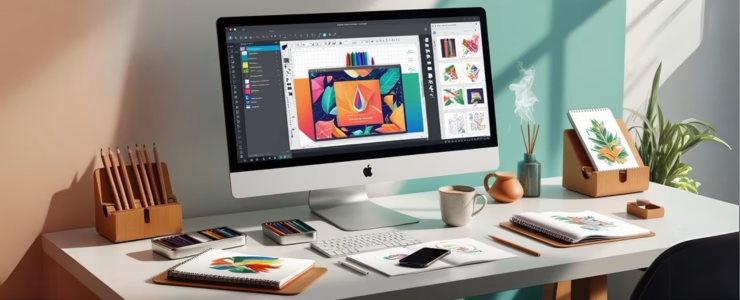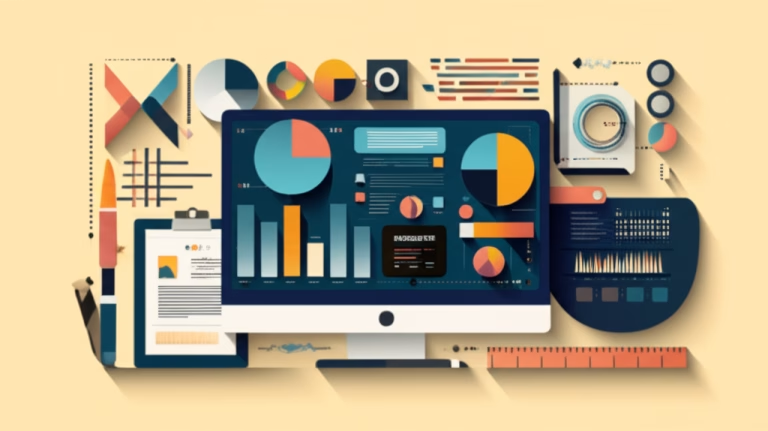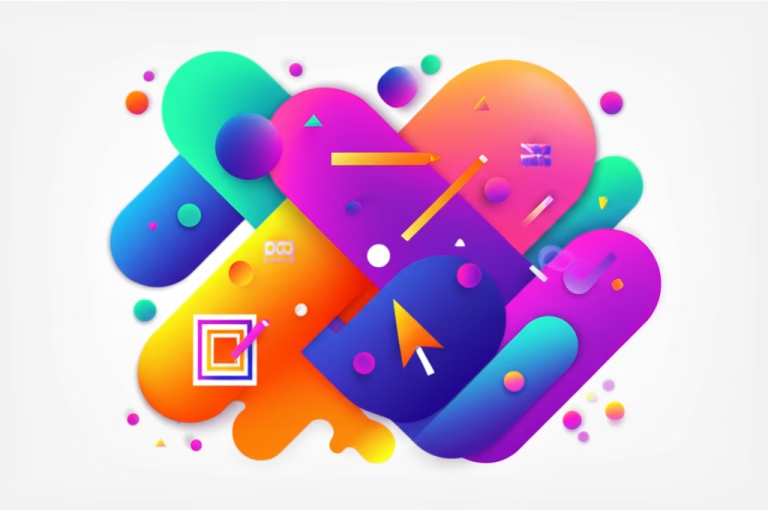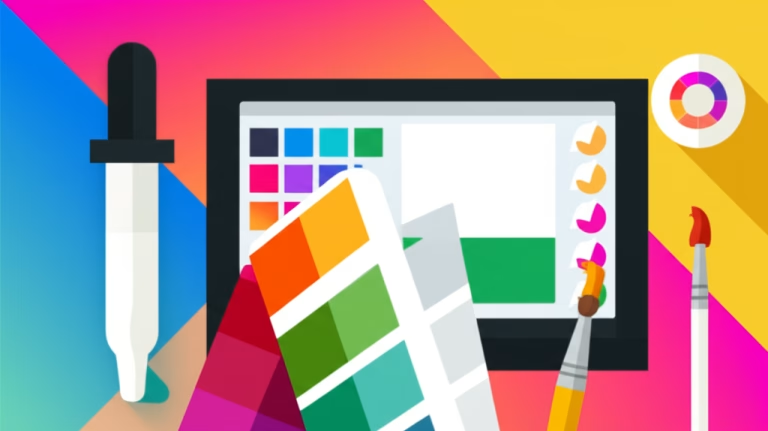If you’re taking your first steps into the world of design, prepare yourself for an exciting and possibility-filled journey! The good news is that you don’t need to invest a fortune to get started. There are several free design tools that can help you create incredible projects, from logos and social media posts to website layouts and printed materials.
In this complete guide, we’ll explore the best available options, demystify some basic concepts, and give you practical tips to start creating quality designs, even without prior experience. Believe me, with the right tools and a little dedication, you can turn your ideas into reality!
Table of Contents
1. Why Choose Free Design Tools?
For beginners, the entry barrier represented by professional design software can be intimidating. Programs like Adobe Photoshop and Illustrator, although extremely powerful, require a considerable investment and a learning curve that not everyone can afford.
Free design tools, on the other hand, offer an accessible and practical alternative. They allow you to experiment with different styles, explore your creative skills, and learn the fundamentals of design without compromising your budget. Moreover, many of these tools are incredibly intuitive and easy to use, making them perfect for beginners.
Advantages of using free tools:
- Zero cost: The main advantage is, without a doubt, the free nature. You can use the tools without worrying about licenses or subscriptions.
- Accessibility: Many tools are web-based, meaning you can access them from anywhere, just with an internet connection.
- Ease of use: Most free tools have intuitive interfaces and tutorials that make learning easier.
- Wide variety of options: There are tools for all types of design, from image editing and vector graphics creation to website prototyping and animations.
- Online communities: Many tools have active online communities where you can find help, share your projects, and learn from other designers.
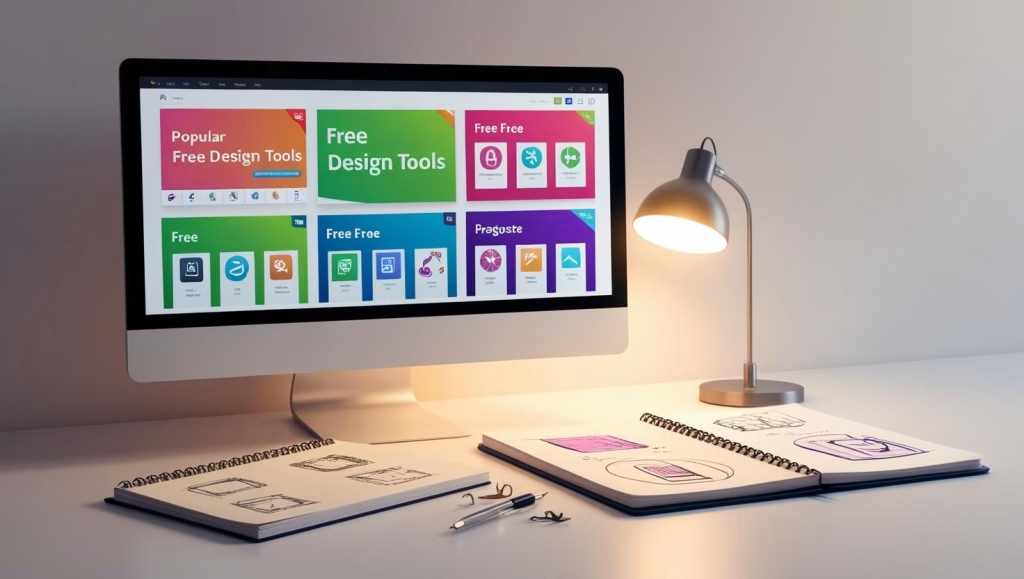
2. The Best Free Graphic Design Tools
Graphic design is a vast and comprehensive field, encompassing various areas such as logo creation, visual identity, marketing materials, editorial design, and more. Fortunately, there are several free graphic design tools that can help you create incredible projects in each of these areas.
2.1. Canva:
Canva is undoubtedly one of the most popular and accessible design tools on the market. With its intuitive interface and vast library of templates, Canva allows you to create professional designs in minutes, even without prior experience.
- Features:
- Creation of posts for social media (Instagram, Facebook, Twitter, etc.)
- Design of presentations, posters, flyers, and other marketing materials
- Image and video editing
- Logo and visual identity creation
- Team collaboration
- Advantages:
- Intuitive and easy-to-use interface
- Vast library of templates and graphic elements
- Available in web version and mobile app
- Generous free plan with many features
- Disadvantages:
- The free version has some limitations regarding features and graphic elements
- Not as powerful as professional design software like Photoshop and Illustrator
Practical example: Imagine you need to create a post to promote an event on Instagram. With Canva, simply choose a pre-designed template, customize the text, add images, and you’re done! Your post will be ready to be published in minutes.
2.2. GIMP (GNU Image Manipulation Program):
GIMP is a free and open-source alternative to Adobe Photoshop. Although its interface may seem a bit intimidating at first, GIMP offers a vast array of tools and resources for image editing, photo retouching, illustration creation, and more.
- Features:
- Layered image editing
- Photo retouching and color correction
- Creation of illustrations and digital paintings
- Selection, cropping, resizing, and transformation tools
- Support for various file formats (JPEG, PNG, GIF, TIFF, etc.)
- Advantages:
- Free and open-source
- Wide variety of tools and resources
- Highly customizable
- Support for plugins and scripts
- Disadvantages:
- Less intuitive interface than Photoshop
- Steeper learning curve
Case study: An amateur photographer who cannot afford Photoshop can use GIMP to retouch their photos, remove imperfections, adjust colors, and create special effects.
Inkscape is a free and open-source vector graphics editor, similar to Adobe Illustrator. With Inkscape, you can create logos, illustrations, icons, diagrams, and other types of graphics that can be resized without losing quality.
- Features:
- Creation of geometric shapes and Bezier curves
- Editing of nodes and paths
- Filling and outlining objects
- Text and typography
- Support for gradients and patterns
- Advantages:
- Free and open-source
- Based on SVG (Scalable Vector Graphics), a standard vector format
- Ideal for creating logos and illustrations
- Active community and large number of online tutorials
- Disadvantages:
- Interface can be a bit confusing for beginners
- Requires a good understanding of vector graphics
3. Free UI/UX Design Tools
UI/UX (User Interface/User Experience) design is a constantly growing field that focuses on creating intuitive, pleasant, and efficient user interfaces. If you are interested in designing websites, mobile applications, or software, the following free design tools can help you create high-quality prototypes and wireframes:
3.1. Figma:
Figma is a cloud-based collaborative design tool that allows you to create interactive user interfaces and prototypes for websites and mobile applications. Figma is known for its intuitive interface, advanced features, and ease of team collaboration.
- Features:
- Creation of wireframes and interactive prototypes
- User interface (UI) design
- Real-time collaboration
- Reusable components
- Plugins and integrations
- Advantages:
- Cloud-based, allowing access from anywhere
- Intuitive and easy-to-use interface
- Real-time collaboration
- Generous free plan with many features
- Disadvantages:
- Requires an internet connection
- The free version has some limitations regarding the number of projects and collaborators
3.2. Adobe XD (Experience Design):
Adobe XD is another popular tool for UI/UX design, developed by Adobe. Adobe XD offers similar features to Figma, such as creating wireframes, interactive prototypes, and designing user interfaces.
- Features:
- Creation of wireframes and interactive prototypes
- User interface (UI) design
- Animations and transitions
- Integration with other Adobe products (Photoshop, Illustrator, etc.)
- Plugins and integrations
- Advantages:
- Integration with other Adobe products
- Advanced animation and transition features
- Active community and large number of online tutorials
- Disadvantages:
- Requires software installation
- Slightly steeper learning curve than Figma
- Free plan with some limitations
Tip: Try both tools (Figma and Adobe XD) and see which one best suits your workflow and needs.
4. Free Animation and Video Design Tools
Animation and video are increasingly popular formats on the internet, and knowing how to create animated content can be an important differentiator for designers. Fortunately, there are some free animation and video design tools that can help you bring your ideas to life:
4.1. DaVinci Resolve:
DaVinci Resolve is a professional video editing software used by many filmmakers and video editors. Although it is paid software, DaVinci Resolve offers a free version with many powerful features, such as video editing, color correction, visual effects, and audio editing.
- Features:
- Non-linear video editing
- Advanced color correction
- Visual effects (VFX)
- Audio editing
- Support for various video formats
- Advantages:
- Professional video editing software
- Free version with many features
- High-quality color correction and visual effects
- Disadvantages:
- Requires a powerful computer
- Steep learning curve
- The free version has some limitations regarding features and video formats
4.2. Blender:
Blender is a free and open-source 3D modeling, animation, and game creation software. With Blender, you can create 3D animations, characters, scenarios, visual effects, and more.
- Features:
- 3D modeling
- 3D animation
- Rendering
- Simulation
- Video editing
- Advantages:
- Free and open-source
- Complete software for creating 3D content
- Active community and large number of online tutorials
- Disadvantages:
- Very steep learning curve
- Requires a powerful computer
- Complex interface
5. Free Fonts, Icons, and Images: Your Best Friends

In addition to design tools, you’ll also need resources like fonts, icons, and images to bring your projects to life. Fortunately, there are several websites that offer these resources for free:
5.1. Fonts:
- Google Fonts: A vast library of free and high-quality fonts that can be used in your web and print projects.
- Font Squirrel: Another excellent website with a wide variety of free fonts, including commercial fonts with free licenses for personal use.
5.2. Icons:
- Flaticon: A huge library of free vector icons, available in various formats (SVG, PNG, EPS, etc.).
- The Noun Project: A collection of minimalist and elegant icons, created by designers from around the world.
5.3. Images:
- Unsplash: A collection of high-resolution and free photos, perfect for using in your design projects.
- Pexels: Another excellent website with a wide variety of free photos and videos.
Tip: When using free resources, always check the usage license to ensure you are using the resources according to the terms established by the author.
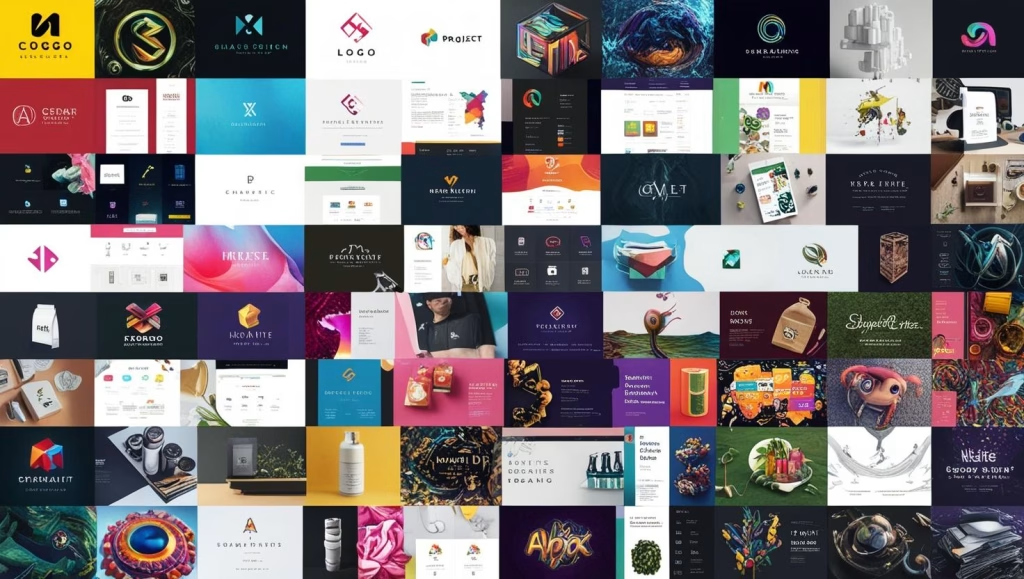
6. Essential Tips for Design Beginners
Now that you know some of the best free design tools and the available resources, here are some essential tips to help you start your journey in the world of design:
- Learn the fundamentals of design: Study the principles of design, such as typography, colors, layout, visual hierarchy, and composition. There are several books, online courses, and tutorials that can help you learn these fundamentals.
- Get inspired: Explore the work of other designers, visit design websites, follow design profiles on social media, and create an inspiration board with your favorite designs.
- Practice, practice, practice: The best way to learn design is by practicing. Create personal projects, challenge yourself to create different designs, and ask for feedback from other designers.
- Ask for feedback: Don’t be afraid to ask for feedback on your designs. Feedback from other designers can help you identify areas for improvement and refine your skills.
- Be patient: Learning design takes time and dedication. Don’t get frustrated if your first designs aren’t perfect. Keep practicing and learning, and you will see progress over time.
- Stay updated: The world of design is constantly evolving. Stay updated on the latest trends, technologies, and design tools.
Recommended books for beginners:
- “The Design of Everyday Things” by Donald A. Norman: A classic about usability design and user experience. (Available on Amazon)
- “Thinking with Type” by Ellen Lupton: A complete guide to typography for designers. (Available on Amazon)

With the right free design tools, a dose of creativity, and a lot of dedication, you can pave a path to success in the world of design. Remember, design is a journey of continuous learning. Explore, experiment, have fun, and never stop learning, so here’s an article to get you started: What is Graphic Design? Essential Concepts for Aspirants
